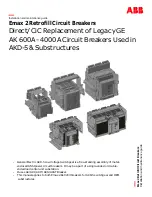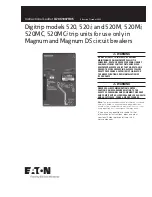
Powered by Safety
®
26
Installation
PowlVac
®
STD Vacuum Circuit Breaker
IB-60201
4) Mechanical Operation Check
The contacts of the vacuum interrupter
during normal operation cannot be closed
unless the secondary disconnect plug is
inserted into the secondary disconnect
receptacle. To check the circuit breaker
outside of the circuit breaker compartment,
it is necessary to simulate the connection
of secondary disconnecting device by
inserting the secondary disconnect
override device (Figure 12) in the secondary
disconnect receptacle. This device must be
removed after testing and before the circuit
breaker is inserted into the compartment.
The mechanical operation of the circuit
breaker is checked by inserting the manual
charging handle into the manual charging
crank and pushing down until a metallic
click is heard. (This indicates that the
holding pawl has dropped into place on
the ratchet wheel). Lift the handle until
it is horizontal and then depress. The
procedure is repeated until the spring
charge indicator indicates
“CLOSING SPRING CHARGED”.
This
requires about 60 operations of the handle.
Remove the handle.
Figure 12 Secondary Disconnect Override
Device
Care must be exercised to keep personnel,
tools, and other objects clear of mechanism
which are to be operated or released.
CAUTION
CAUTION
!
Push the manual close operator
(Figure 1, n) inward and the circuit breaker
will close. The circuit breaker open/closed
indicator located above the manual close
operator will now display
“BREAKER CLOSED”.
Push the manual
trip operator (Figure 1, h) inward, which is
located at the top of the escutcheon and
the circuit breaker open/closed indicator
will now display
“BREAKER OPEN”.
5) Electrical Operation Check
To check the basic electrical operation
of the circuit breaker, a circuit breaker
test cabinet should be used. Connect
the secondary disconnect from the
test cabinet to the circuit breaker to be
tested. The test cabinet provides control
voltage via a secondary disconnect plug
to the circuit breaker and the appropriate
control switches to verify the close and
open functions of the circuit breaker.
Specialized versions of the test cabinet
may also contain circuits for circuit
breakers equipped with dual shunt trip
coils, undervoltage devices, or other
options. With the secondary disconnect
plug installed in the circuit breaker under
test, operate the power switch on the
test cabinet. The charging motor will
automatically charge the stored energy
mechanism’s main closing springs.
Operation of the control switch on the
front door of the test cabinet to the “close”
position will cause the circuit breaker to
close.





































